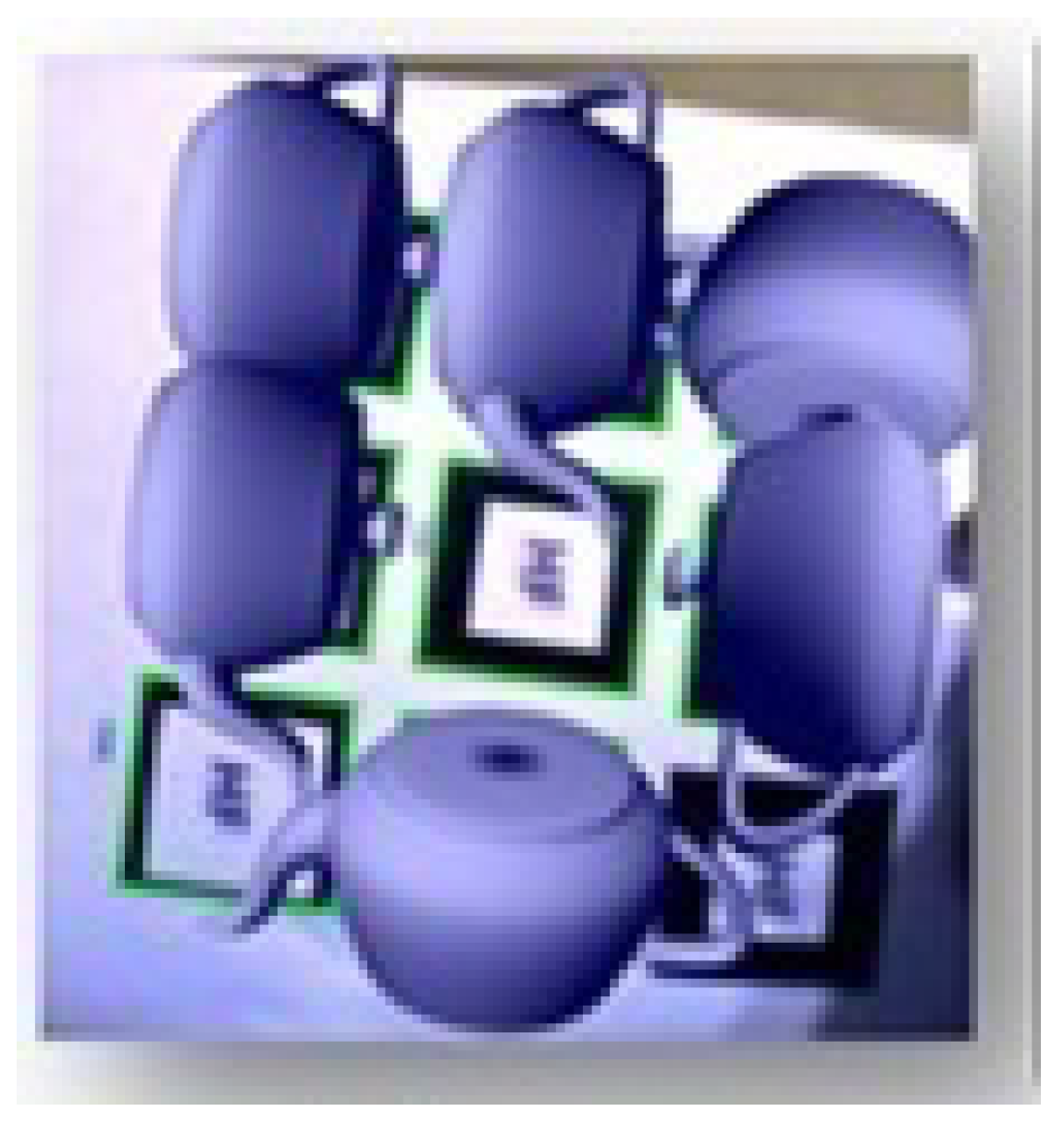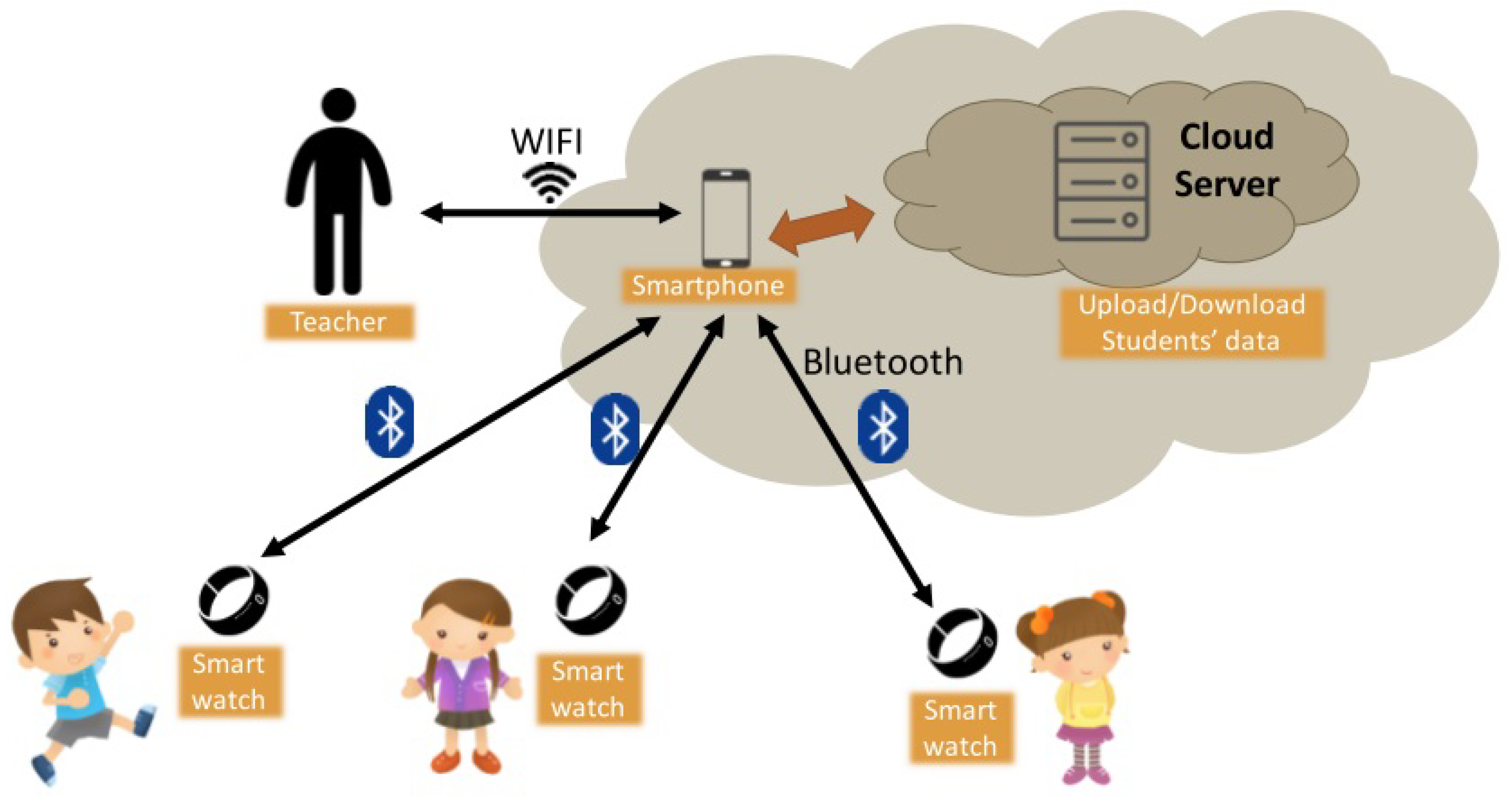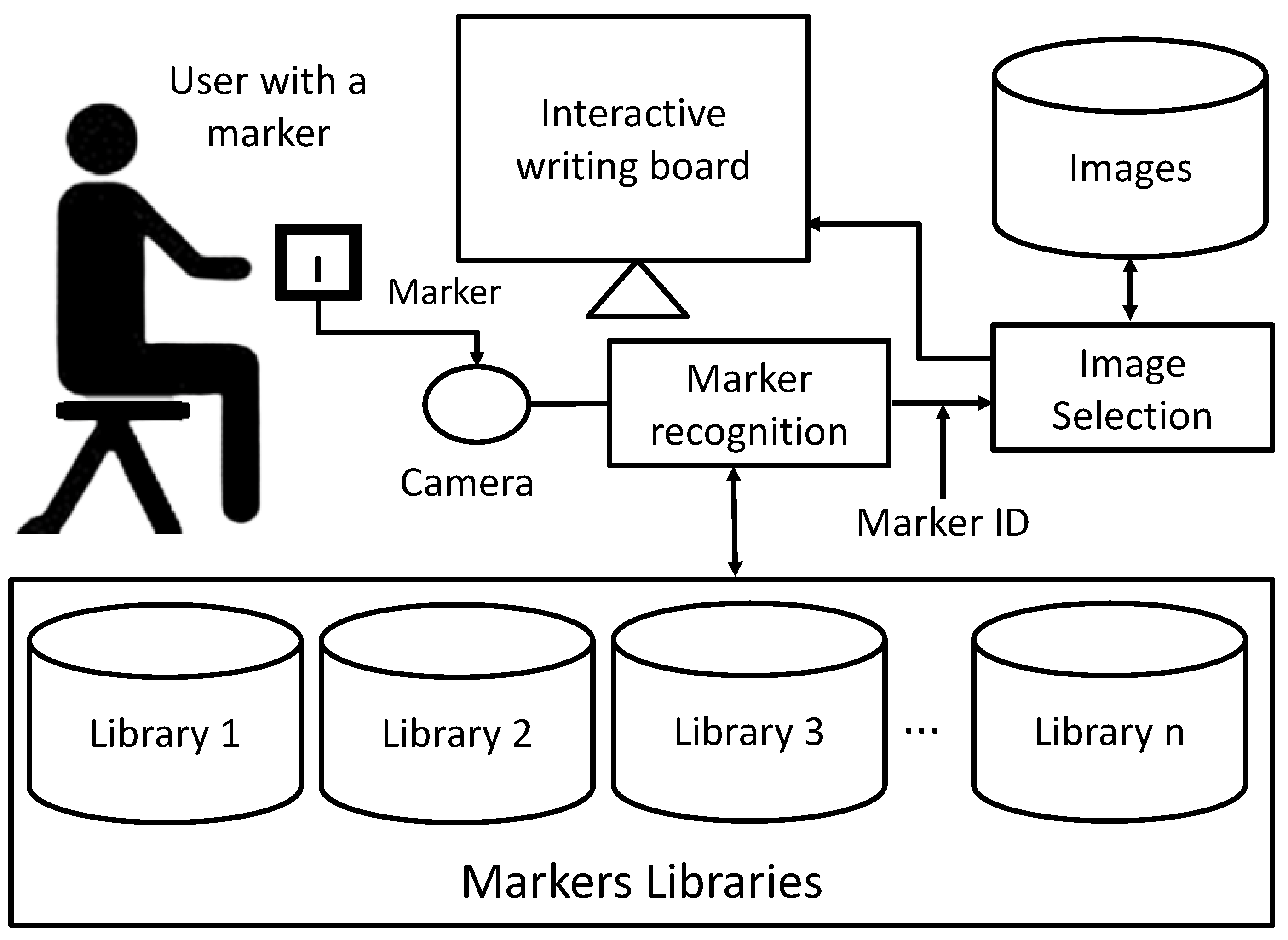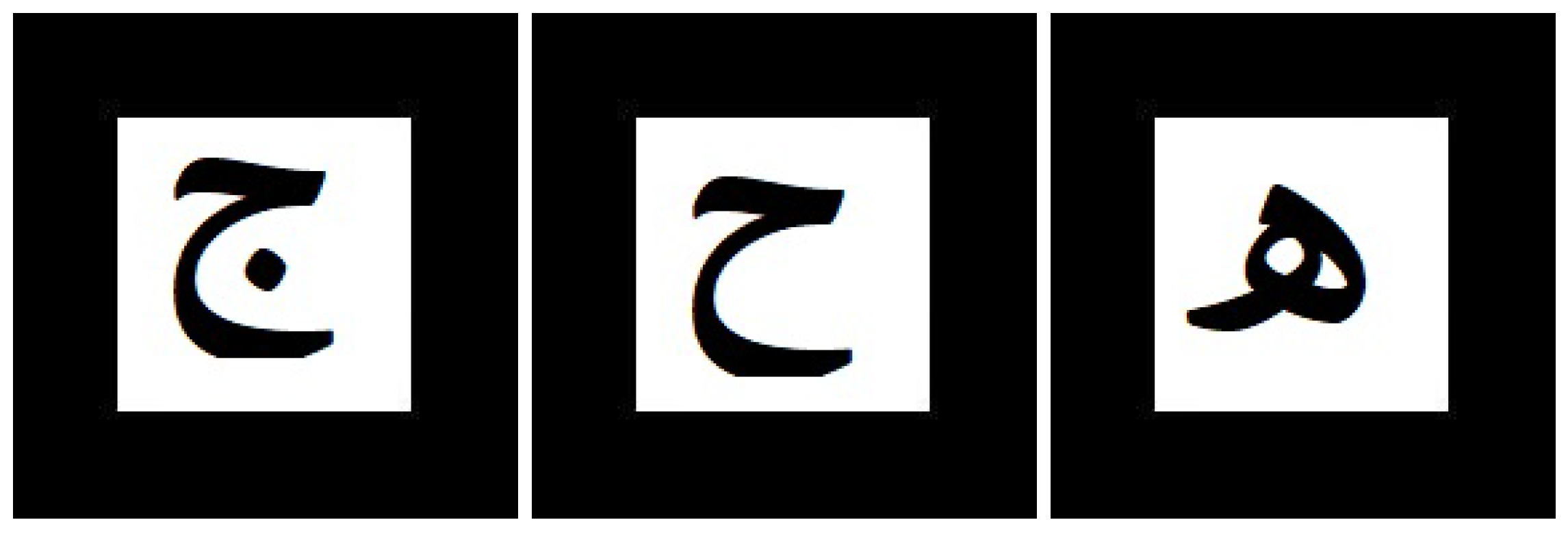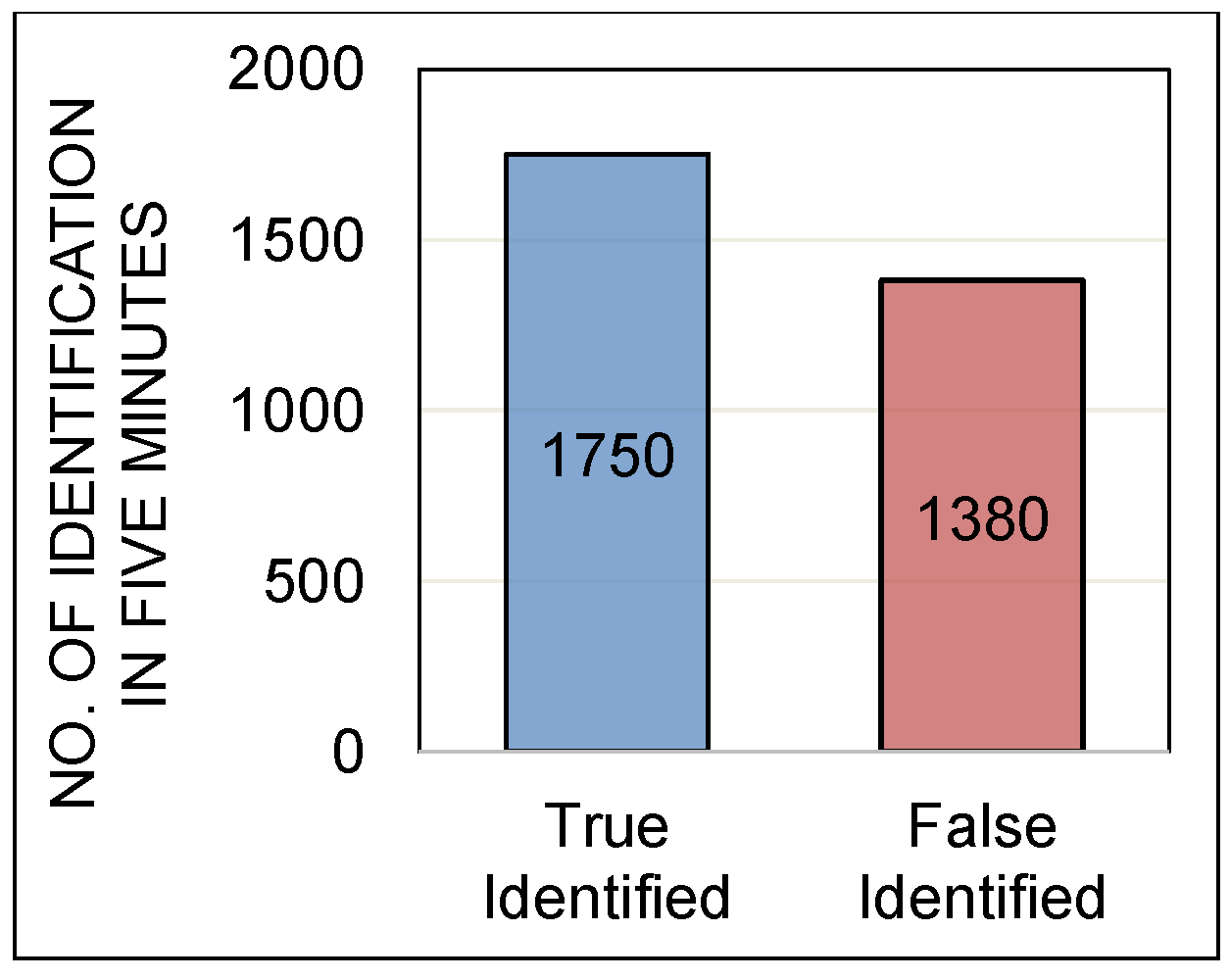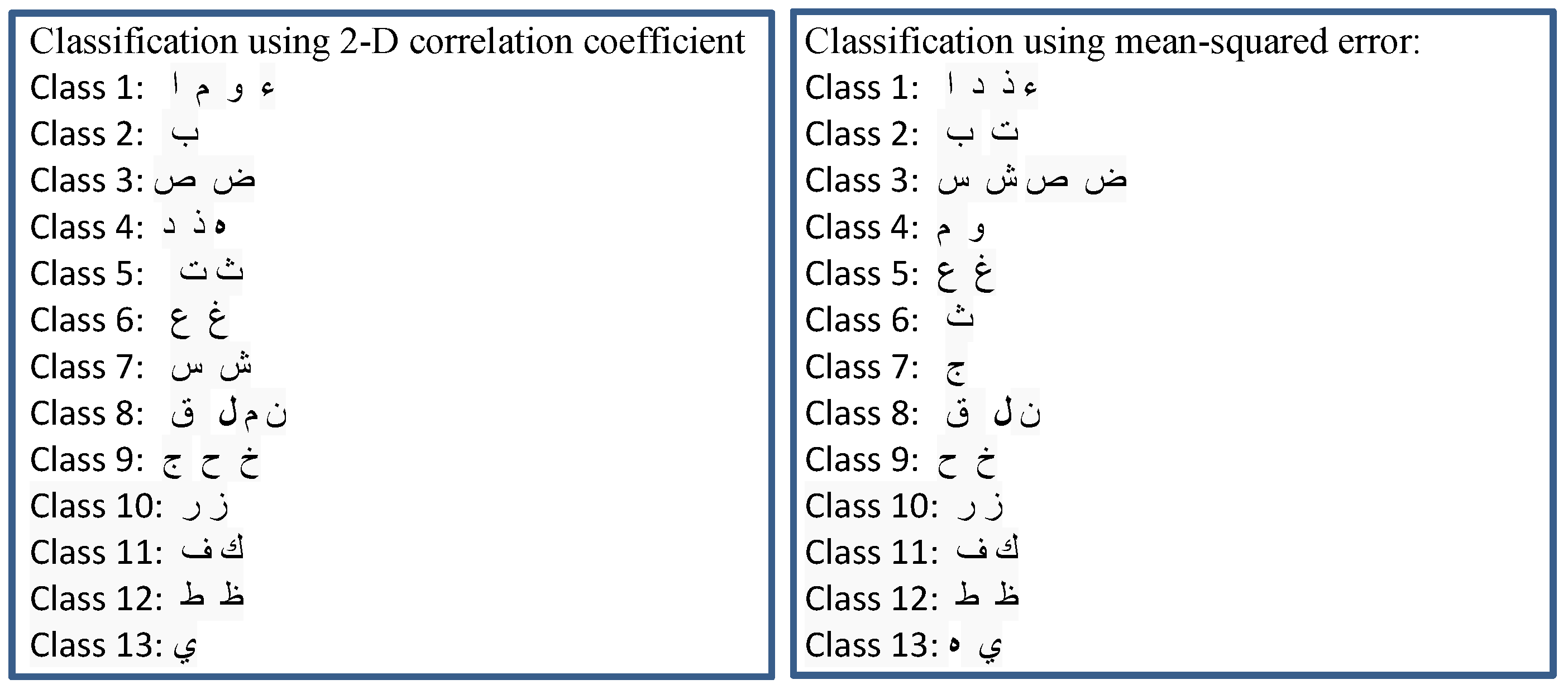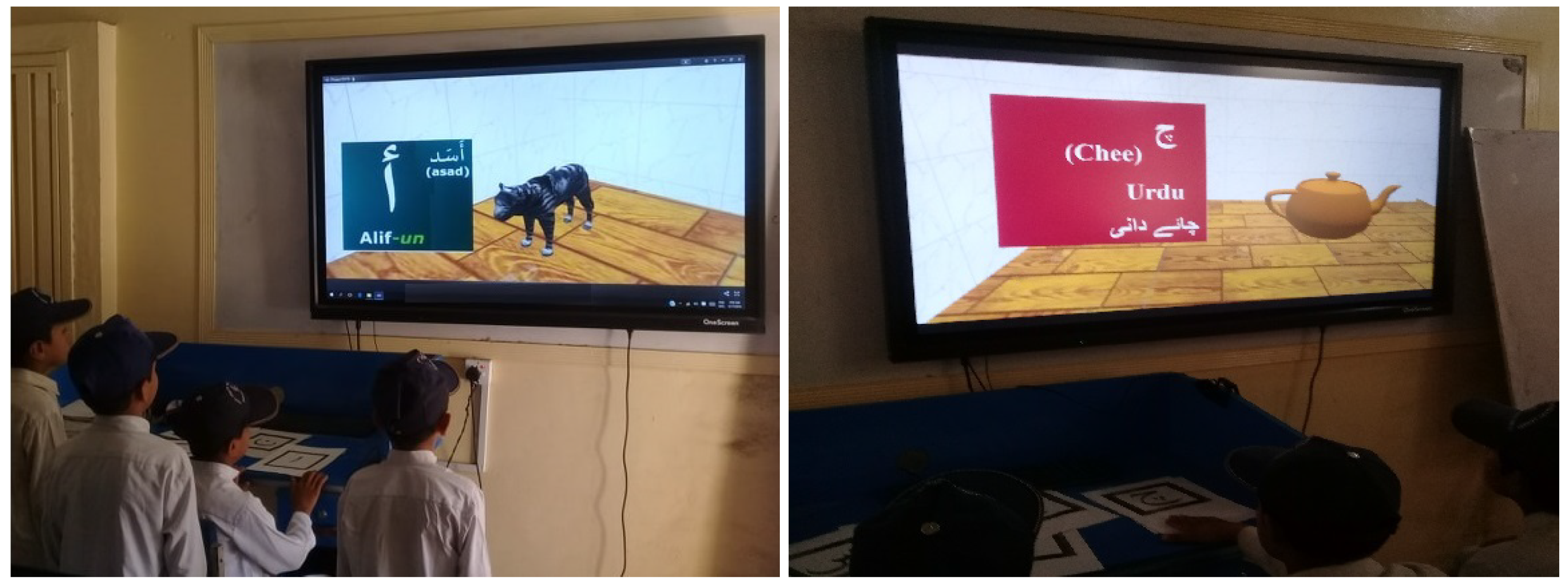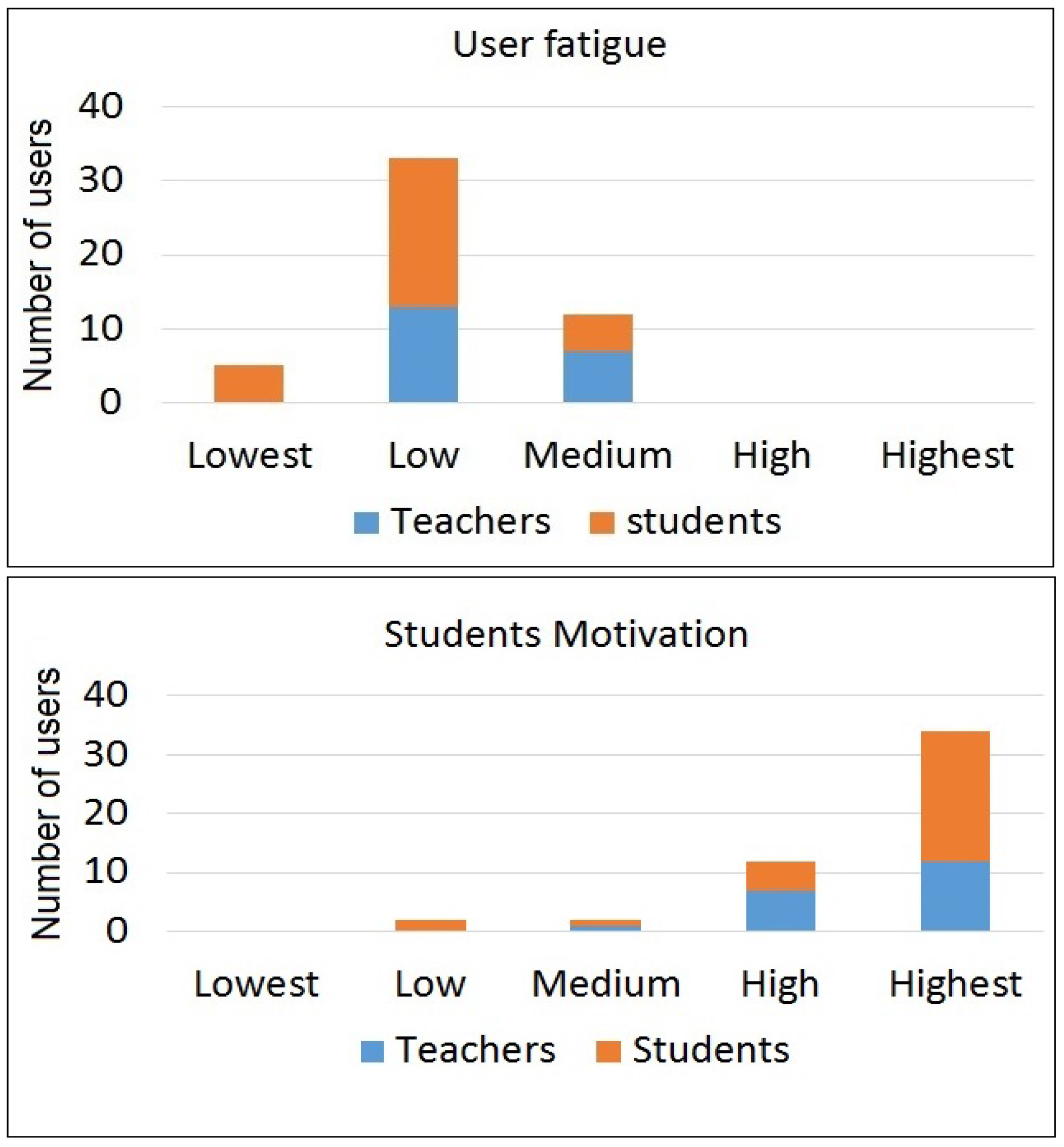1. Introduction
Technology-enhanced learning systems are rapidly growing with amazing improvements in classrooms and educational environments. These systems are significantly improving students’ motivation and learning skills. However, the use of these systems is not so common, due to either their high cost or their complexity in use. Therefore, cost-effective and easy-to-use technology-enhanced systems are needed in educational environments.
ARToolKit is an open-source and simple tool used in various augmented reality (AR) applications [
1]. ARToolKit has no additional costs as it uses printed images detected by a video camera for pose estimation and/or human-computer-interactions. However, if the marker distinctions are not ensured, the markers are often miss-recognized due to inter-marker confusion. Typically, a single Latin character is added in ARToolKit markers as its inside pattern [
2]. In order to make it more user-friendly the pattern can also be written in other languages like Arabic, Urdu, Pashtu, or Persian. However, marker distinction becomes more difficult when the characters have a similar structure. Therefore, the user needs to follow some mechanism during marker designing or library management phase to avoid possible inter-marker confusion.
Ullah et al. [
3] used ARToolKit, which is an easy solution at a low cost. However, their board only has the capability of writing characters with no graphical images. Furthermore, their board has different modules, each with a different marker. For example, one marker is used for writing, one is used for cleaning the board, and similarly one for the saving option and one for the opening option. To memorize all these markers for different tasks is difficult for primary level students. In addition, even if students can remember the markers, this has no relation to their learning and education.
In this paper we present an easy-to-use interactive writing board (IWB) for teaching Urdu and Arabic characters in primary education. The board uses ARToolKit markers for interaction. Each marker has a single character of the Urdu or Arabic language. First, we ensure the marker distinction by classifying the markers into different classes. The classification algorithm uses the K-means algorithm which classifies the markers based on their degree of similarities with other markers. Then, we use each class of markers as a single ARToolKit library for the IWB. With the detection of each character, the system displays a relevant image that helps students to understand the character and its pronunciation.
The system was evaluated by teachers and students in August 2019. Three groups of users including group 1 (30 students, 4 to 7 years in age), group 2 (30 students, 8 to 12 years in age), and group 3 (20 teachers, 22 to 60 years in age) were randomly selected. The evaluation was carried out in the primary-level educational institutes of Malakand district, Khyber Pakhtunkhwa, Pakistan. The evaluation results revealed that the system improved students’ motivation and learning skills. In addition, the system was compared with a previous IWB [
3], and was found to have better performance, was easier to use, and was more attractive for the students.
The rest of this paper is organized as follows.
Section 2 defines the basic terms used in this paper and
Section 3 covers the related work.
Section 4 describes the classification method and
Section 5 presents the proposed writing board.
Section 6 presents the experimental results. Finally,
Section 7 concludes the paper with possible future improvements.
2. Preliminaries and Definitions
In this section, we present definitions of the basics terms including augmented reality, ARToolKit, and the Arabic and Urdu alphabet sets.
2.1. Augmented Reality
Augmented reality (AR) augments virtual objects over the real-world environment, in order to improve the user perception of the environment [
4,
5,
6]. AR is widely used in various fields including teaching and learning [
7,
8,
9], robot navigation [
10], tour sharing [
11], video conferences [
12], medical, entertainment, military, robotics, manufacturing, maintenance, and repairing [
13].
2.2. Fiducial Markers and ARToolKit
Different toolkits such as ARTag [
14], ARToolKit and ARToolKit Plus [
15] are used for marker tracking. Fiducial markers are printed images, recognized via video camera, and used for human-computer interaction or information visualization [
16]. Fiducial markers are used in various AR applications, such as robot navigation [
10], 3D modeling [
17], and education and learning aids [
8,
9,
18]. The markers are used for accurate pose estimations [
19].
Figure 1 shows a screenshot of virtual solid teapots overlaying the detected ARToolKit markers.
2.3. Arabic and Urdu Alphabets
The Arabic language alphabet set contains 29 different characters as shown in
Figure 2. The Arabic language and many other languages like Urdu, Pashtu, and Persian are written from right to left and have similar writing rules. Language processing and text recognition of the Arabic language have several challenges and therefore has remained an active research area [
20,
21].
The use of Arabic characters in ARToolKit markers instead of Latin characters or other graphical objects will make the AR application more user-friendly for students. However, Arabic characters are mostly similar in shapes, thereby causing more inter-marker confusion in the ARToolKit. Therefore, it is desirable to find a similarity among the markers having a pattern of Arabic characters and classify them into different groups. The Urdu alphabet set contains 37 characters as shown in
Figure 3 which contains all the Arabic characters with some more additional characters.
3. Related Work
Various studies have been conducted in the field of marker-based AR on the quality and applications of fiducial markers. This section covers the literature review on fiducial markers and their quality. In addition, the ARToolKit library and the problem of inter-marker confusion are also discussed.
3.1. Inter-Marker Confusion in ARToolKit Library
Marker-based tracking is a popular method in AR where predefined markers are placed in the real scene, from which their position can be calculated [
5]. ARToolKit [
1] uses these markers to interact with virtual objects in a real world environment [
22]. The pattern inside the ARToolKit markers typically causes inter-marker confusion [
2]. Badeche and Benmohammed proposed a marker classification mechanism to reduce inter-marker confusion [
2]. They tested 26 different markers, each with a single Latin alphabet in its interior white region. They performed an experiment for each marker using ARToolKit, computed the degree of similarity with each of the 26 markers. Finally, they applied the
K-means algorithm on the stored experimental results and classified these markers into seven different classes. They also repeated the experiments for different values of k. For minimal inter-marker confusion, they recommended the use of characters of different classes and especially advised the use of characters from smaller classes [
2]. The classification is useful, however it is not applicable if someone uses markers that have a pattern rather than a single Latin character.
Khan et al. [
23] studied 11 factors that affect ARToolKit marker recognition. They conducted detailed experiments by varying these factors. They identified the optimal values for these factors to be used for robust marker recognition. These factors include (1) black to white ratio, (2) sharp and de-noised edges, (3) the complexity of the marker, (4) intensity of the light, (5) the pose of marker to camera and light source, (6) smoothness of marker surface, (7) movement of the marker, (8) frame rate, (9) marker segmentation, (10) resolution of the camera, and (11) quality of the printer used.
The automation of the marker design process is gaining the attention of researchers in marker-based AR. Layered marker generation tool (LMGT) [
24] is a tool used for layered marker creation. Similarly, the black to white ratio [
25] and the noise in the marker [
26] also affect marker recognition. To ensure the distinction of all existing markers in the library, is a challenging task. Recently, Khan et al. [
27] introduced a tool called FMO (fiducial marker optimizer) for designing a high-quality marker. FMO [
27] also recommends marker classification for ensuring marker distinctions. Image correlation [
28] based classification also has a similar recommendation for using a marker from a smaller size class after marker classifications.
3.2. Interactive Writing Boards and Technology-Enhanced Learning
Technology-enhanced learning is significantly improving the teaching and learning methodologies because it allows students to access, extend, change, and exchange concepts, ideas, and knowledge in a multi-modal fashion [
29]. Interactive writing boards (IWB) play a vital role in enhancing student interest and their learning skills [
3]. Vergara et al. [
30] proposed an active methodology to increase motivation for secondary school students in mathematics courses. The method [
30] recommends a small group (four students) for effective learning. Hartono et al. [
31] presented a game-like 2D cartoon art for teaching mathematics to primary level students.
Horii and Miyajima presented an ARToolKit-based education system for visualizing and teaching mechanical drawing [
32]. They used cubic ARToolKit markers where the user can watch the objects from different directions by rotating the cubic marker. Their system is efficient and cost-effective. However it is limited to mechanical drawing.
Recently, Liang et al. [
33] proposed an intelligent interactive system for teaching.
Figure 4 shows the overall pipeline of this system. This system [
33] uses smart watches and smart phones to capture the hand gestures of the users (students) and respond in real-time to teachers, thus increasing student interaction an motivation. However, the use of smart watches by all students is expensive in terms of costs. Similarly,
[
34] is another system that gives a technical resource to the users (students/teachers) in the classrooms. It improves the users’s development skills and prepares them for programming and game design. The system improves engagement between students and teachers in the classroom.
4. Marker Classification and Library Management
Our writing board (
Section 5) is based on ARToolKit markers. However, there exists confusion among the Arabic/Urdu characters. Therefore, we need to organize the markers as a lesson plan into different groups such that to minimize the inter-marker confusion. The teacher will set the library according to the lesson plan before starting the lesson. In this section, we describe the marker classification strategy.
The method described in [
27,
28] is followed for marker classification with a new variation of MSE. The algorithm for classification of markers into
k classes is given in Algorithm 1:
| Algorithm 1 MarkersClassification(MarkersLibrary[n], K). |
- 1:
- 2:
fordo (i) (ii) for do (*) (*) (*) (*) end inner for loop end outer for loop - 3:
- 4:
|
This algorithm takes all the markers from the library and the
k value (i.e., the number of classes), as input. In the initial step, the algorithm counts the total number of markers in the ARToolKit library. For example for Arabic character
, whereas for Urdu
. In the second step, all the markers along with their numeric values for the similarity between any two markers are added to a
N × N Table i.e., the
ResultsMatrix (see example in
Table 1). Here the similarity is computed by using either correlation or MSE between the two markers. A lower value for MSE indicates a smaller error and a higher similarity. In the correlation, the higher value indicates the two markers are more similar. In the next step (third step), the markers are grouped into the given number (
k), distinct groups.
For similarity computation, two methods were used. One was image correlation (2D correlation coefficient) which was previously used in our marker designing tool [
27] for calculating the similarity between the two markers. The second method was a mean-squared error (MSE) between the two markers. For MSE each marker is converted to
class.
5. The Writing Board and Marker Libraries
We classified the markers into seven different classes using the MSE method. We used this classification and design six ARToolKit libraries in such a way that none of the two markers from the same class lay in the same library.
Figure 5 shows the classification with the corresponding libraries.
Each single marker was then used for writing a single Arabic/Urdu character on the IWB.
Figure 6 shows the overall working mechanism of the proposed system. A user (student/teacher) brings a marker in front of the camera. The marker recognition system detects a marker and then recognizes it by comparing it with all existing markers in the library. The ID of the recognized marker is sent to the image selection system. The image selection system picks the corresponding image from the images library and sends it to the display module (i.e., IWB). The white board is a display screen which displays a single character with recognition of the corresponding marker. A virtual character that starts with this character is also displayed on the board.
A teacher sets the ARToolKit library and asks the students to bring different markers in front of the camera. The students pick a marker, bring it to the front of the camera, and see the resultant image on the 2D board. The board also has a 3D mode where the character is displayed on the 2D screen while the corresponding image is displayed in the background as a 3D scene.
Figure 7 shows a screenshot of teaching/learning the Urdu character (alif) with the proposed IWB.
6. Experimental Results
This section describes the experimental results in two categories.
Section 6.1 presents the marker classification results, whereas
Section 6.2 presents the results from the user study. Furthermore, a comparison with a previous IWB [
3] is also given.
6.1. Classification Results
The correlation method for similarity checking has been tested in [
26] and FMO [
27], which shows that the correlation method has a semantic relationship with the ARToolKit matching algorithm. Our first experiment was the illustration of our classification method using three different markers shown in
Figure 8.
Table 1 shows the similarity computed for these markers. If we apply
K-means with
, in both cases (correlation and MSE) the Jeem and Haa1 are in class 1 and Haa2 is in class 2.
In the second experiment, a simple experiment was performed to show the significance of marker library management. In this experiment, three markers’ library were used as shown in
Figure 8. We executed the ARToolKit and moved the marker with character Jeem (
Figure 8 (Left)). We noted true detections (marker was detected as Jeem) and false detections (marker was detected as Haa1). The true detections amounted to 1750 whereas there were 1380 false detections, which means a huge rate of false detection (see
Figure 9).
The third experiment was the classification of all 29 characters of the Arabic language, for which we designed 29 ARToolKit markers each containing an isolated character as a pattern (see
Figure 10).
Table 2 shows the
matrix containing the similarities among different characters using the binary correlation method. We set the value of
K and apply the
K-means algorithm to classify these 29 markers. We repeated the experiments with different values of
K, some of them are given here.
For
K = 7, we got the seven classes shown in
Figure 11. Both methods give different classifications. However, based on the structure of the ARToolKit markers and its detection mechanism, we recommend MSE for marker classification.
Similarly, for
, we got 13 classes as shown in
Figure 12. We recommend this classification for ARToolKit as it provides enough library size and with minimal inter-marker confusion. In addition, the value of K can be changed to get a different number of classes as desired in our AR application. Here again both methods have different results, but still the classes are matching. Either method can be used to classify a marker library and eliminate possible confusion in the markers library.
6.2. Results Concerned with the Writing Board and Students’ Learning
We conducted a similar subjective study like that of Ullah et al. [
3] using 30 primary level students (Group 1: 22 male, and 8 female) with an age range from 4 to 7 years (for easy questions i.e., Q1–Q6, which compare our system with an existing system [
3]). We also conducted further analysis on another group of students (Group 2: 25 male, and 5 female) with an age range from 8 to 12 years. In addition, we also conducted the subjective analysis with 20 teachers (Group 3) who participated in all experiments. The participants (students and teachers) were randomly selected for the experiments. We noted the opinions of the users and compared our results with Ullah et al. [
3]. We asked the following questions from each user.
- Q. 1:
Which of the two writing boards is easy to use?
- Q. 2:
Which of the two writing boards is more interesting?
- Q. 3:
Which of the two writing boards do you like more?
- Q. 4:
Which of the two writing boards is better for group study?
- Q. 5:
Which of the two writing boards looks similar to a traditional board (physical board)?
- Q. 6:
Which of the two writing boards makes you more tired?
For further analysis (i.e.,
Table 3 and
Table 4), we needed mature students. Therefore, group 1 was replaced by group 2 and group 3 remained unchanged.
Figure 13 shows students interacting with the proposed board.
Figure 14 shows the results collected from users (group 1 and group 3) after the experiments whereas
Figure 15 shows the results collected from users (group 2 and group 3) on user fatigue and student motivations. Similarly,
Table 3 and
Table 4 show the corresponding numerical results of the user study. The results show that our system had a significant improvement over Ullah et al. [
3]. The results further reveal that our system gave less fatigue and motivated students by increasing their interest in the classroom.
7. Discussion and Conclusions
In this paper we presented a simple and easy-to-use interactive writing board. The board used simple ARToolKit markers that had a single Arabic or Urdu character as a pattern. We contributed in two aspects. Our first contribution was from the computer graphics point of view, i.e., ARToolKit library management to reduce inter-marker confusion. We found a high false-positive rate (recognizing one marker as another one) in ARToolKit markers. Therefore, we used a simple yet effective mechanism to avoid inter-marker confusion. The mechanism computed the degree of similarity between two characters in a semantical similar manner as used in the ARToolKit library. Though there were four different positions of Arabic characters including first, middle, last, and isolated [
20,
21,
35]. Our work was only concerned with Arabic characters in their isolated positions. There are 29 characters in the Arabic language as shown in
Figure 2. We designed 29 ARToolKit markers, each having an isolated Arabic character in its interior white region (see
Figure 10). The same was repeated for 37 Urdu characters (
Figure 3).
We used two different methods for computing similarity between two markers. One was image correlation (2D correlation coefficient) which was previously used in a marker designing tool [
27]. The second method was mean-squared error (MSE) between the two markers. Then the
K-means algorithm was used to classify these markers based on the computed degree of similarities. The markers if selected from different classes will have minimal inter-marker confusion. The maker that was in a small class size with a larger number of classes (
k), was the most distinguishable. Inspired by this observation, we classified the markers into seven different classes. Based on this classification, we created different ARToolKit libraries used for writing on an interactive writing board (IWB). This classification solved the issue of the inter-marker confusion.
The second main contribution is in the field of education in the form of the IWB, i.e., a computer application for education. We designed an easy-to-use interactive writing board for teaching isolated Arabic/Urdu characters using ARToolKit markers. The IWB displayed a character/image after recognition of the ARToolKit marker. The displayed character/image is selected such that its name starts with the character on the recognized marker, which helps students to learn the character and its pronunciation.
In the experimental study, we first showed our classification of the markers. Then, we evaluated the proposed IWB via students’ and teachers’ opinions. We also gathered users opinions to compare the current board with a previous one [
3]. Experimental results revealed that the IWB improved student interest and was relatively easy to use. Furthermore, users preferred to our current board instead of the previous one [
3]. The evaluation results were collected from a particular sample of participants in the Malakand district of Khyber Pakhtunkhwa, Pakistan. Changing the participants (from the same place or other) may give different results.
Limitations: There are three main limitations of the current work. (1) The board uses a single camera, therefore it is applicable to small groups only ( students). One solution is to use multiple cameras, however, it may increase the cost. (2) We grouped the distinct characters in one class which contradicts the actual teaching methodologies where similar characters are placed together. (3) The current system is only used for teaching single characters in their isolated forms.
Future work: For future work, we are planning to use the concept of layered markers [
24] for concatenation of these characters, which will be used for Urdu, Arabic, and Pashtu characters. We also plan to use the concept of layered markers for interaction with different 3D objects on the board.
Author Contributions
D.K. and I.u.R. initiated the idea and implemented the software. I.u.R. and S.U. conducted the user study. D.K. wrote the paper. I.u.R. helped in the writing and experimental analysis. W.A. and G.J. reviewed the paper, and helped in the paper writing and experimental analysis. S.U., Z.C. and H.K. supervised the project, reviewed the paper and helped in the experimental design.
Acknowledgments
This work was partially supported by the NSFC (61972388), the CAS grant (GJHZ1862), and the Shenzhen Basic Research Program (JCYJ20180507182222355). We are thankful to the anonymous reviewers for their valuable suggestions. We are also thankful to the experiments’ participants.
Conflicts of Interest
The authors declare no conflict of interest.
References
- Kato, H.; Billinghurst, M.; Poupyrev, I. ARToolKit Version 2.33. 2000. Available online: www.tinmith.net/lca2004/ARToolkit/ARToolKit2.33doc.pdf (accessed on 27 August 2019).
- Badeche, M.; Benmohammed, M. Classification of the Latin alphabet as Pattern on ARToolkit Markers for Augmented Reality Applications. World Acad. Sci. Eng. Technol. 2012, 6, 386–390. [Google Scholar]
- Ullah, S.; Khan, D.; Rahman, S.U.; Alam, A. Marker based interactive writing board for primary level education. Pak. J. Sci. 2016, 68, 366–371. [Google Scholar]
- Patkar, R.S.; Singh, S.P.; Birje, S.V. Marker Based Augmented Reality Using Android OS. Int. J. Adv. Res. Comput. Sci. Softw. Eng. (Ijarcsse) 2007, 3, 64–69. [Google Scholar]
- Sun, R.; Sui, Y.; Li, R.; Shao, F. The Design of a New Marker in Augmented Reality. In Proceedings of the 2011 International Conference on Economics and Finance Research, Singapore, 26–28 February 2011; pp. 129–132. [Google Scholar]
- Rabbi, I.; Ullah, S. A Survey on Augmented Reality Challenges and Tracking. Acta Graph. 2013, 24, 29–46. [Google Scholar]
- Tzima, S.; Styliaras, G.; Bassounas, A. Augmented Reality Applications in Education: Teachers Point of View. Educ. Sci. 2019, 9, 99. [Google Scholar] [CrossRef]
- Thiengtham, N.; Sriboonruang, Y. Improve Template Matching in Mobile Augmented Reality for Thai Alphabet Learning. Int. J. Smart Home 2012, 6, 25–32. [Google Scholar]
- Shetty, C.G.; Ujawal, U.J.; Joseph, J.; Chidananda, K. Interactive Digital Learning System (IDLS). Int. J. Adv. Res. Comput. Sci. Softw. Eng. (Ijarcsse) 2012, 2, 479–494. [Google Scholar]
- Luke, R.; Bradshow, K. Fiducial Marker Navigation for Mobile Robots; Rhodes University: Grahamstown, South Africa, 2012; pp. 129–132. [Google Scholar]
- Lin, H.F.; Chen, C.H. Combining the Technology Acceptance Model and Uses and Gratifications Theory to examine the usage behavior of an Augmented Reality Tour-sharing Application. Symmetry 2017, 9, 113. [Google Scholar] [CrossRef]
- Kato, H.; Billinghurst, M. Marker Tracking and HMD Calibration for a Video-based Augmented Reality Conferencing System. In Proceedings of the 2nd IEEE and ACM International Workshop on Augmented Reality (IWAR ’99), Washington, DC, USA, 20–21 October 1999; pp. 85–94. [Google Scholar]
- Vallino, J.R.; Brown, C.M. Interactive Augmented Reality. Ph.D. Thesis, The College Arts and Sciences, University of Rochester, New York, NY, USA, 1998. [Google Scholar]
- Fiala, M. ARTag, a Fiducial marker system using digital techniques. In Proceedings of the Computer Vision and Pattern Recognition, Ottawa, ON, Canada, 20–25 June 2005; pp. 590–596. [Google Scholar]
- Wagner, D.; Schmalstieg, D. ARToolKitPlus for Pose Tracking on Mobile Devices. In Proceedings of the 12th Computer Vision Winter Workshop (CVWW’07), Graz University of Technology, Graz University of Technology, St. Lambrecht, Austria, 6–8 February 2007; 2007; pp. 139–146. [Google Scholar]
- Fiala, M. Designing highly reliable fiducial markers. IEEE Trans. Pattern Anal. Mach. Intell. 2010, 32, 1317–1324. [Google Scholar] [CrossRef] [PubMed]
- Fiala, M. Comparing ARTag and ARToolkitPlus Fiducial Marker Systems. In Proceedings of the HAVE 2005-IEEE International Workshop on Haptic Audio Visual Environments and Applications, Ottawa, ON, Canada, 1–2 October 2005; pp. 148–153. [Google Scholar]
- Kumar, A.; SahityaPriyadharshini, K. A Survey of ARToolkitBased Augmented Reality Applications. J. Comput. Appl 2012, 5, 261–264. [Google Scholar]
- Russel, M.F.; Julier, S.J.; Steed, A.J. A Method for Predicting Marker Tracking Error. In Proceedings of the Sixth IEEE and ACM International Symposium on Mixed and Augmented Reality, ISMAR’07, Nara, Japan, 13–16 November 2007; pp. 157–160. [Google Scholar]
- Saeed, K.; AlBakoor, M. A new feature extraction method for TMNN-based Arabic character classification. Comput. Inform. 2007, 26, 403–426. [Google Scholar]
- Haraty, R.; Ghaddar, C. Arabic Text Recognition. Int. Arab. J. Inf. Technol. 2004, 1, 156–163. [Google Scholar]
- Vriends, T.; Coroporaal, H. Evaluation of High Level Synthesis for the Implementation of Marker Detection on FPGA. Master’s Thesis, Eindhoven University of Technology, Eindhoven, The Netherlands, 2011. [Google Scholar]
- Khan, D.; Ullah, S.; Rabbi, I. Factors affecting the design and tracking of ARToolKit markers. Comput. Stand. Interfaces 2015, 41, 56–66. [Google Scholar] [CrossRef]
- Rabbi, I.; Ullah, S.; Khan, D. Automatic generation of layered marker for long range augmented reality applications. Kuwait J. Sci. 2017, 44, 44–55. [Google Scholar]
- Khan, D.; Ullah, S.; Rabbi, I. Optimality of black to whit ratio and information complexity for robust marker recognition. In Proceedings of the 4th International Conference on Image Processing Theory, Tools and Applications, Paris, France, 14–17 October 2014; pp. 283–288. [Google Scholar]
- Khan, D.; Ullah, S.; Rabbi, I. Sharp-edged, De-noised and Distinct (SDD) markers creation for ARTooKit. In Proceedings of the 20th International Conference on Information and Software Technology, Druskininkai, Lithuania, 9–10 October 2014; pp. 396–407. [Google Scholar]
- Khan, D.; Ullah, S.; Yan, D.; Rabbi, I.; Richard, P.; Hoang, T.; Billinghurst, M.; Zhang, X. Robust Tracking Through the Design of High Quality Fiducial Markers: An Optimization Tool for ARToolKit. IEEE Access 2018, 6, 22421–22433. [Google Scholar] [CrossRef]
- Khan, D.; Ullah, S.; Rabbi, I. Classification of Markers in the ARTool Kit Library to Reduce Inter-marker Confusion. In Proceedings of the 2014 12th International Conference on Frontiers of Information Technology, Islamabad, Pakistan, 17–19 December 2014; pp. 269–273. [Google Scholar]
- Chien, Y.H. Technology-Enhanced Learning: An Optimal CPS Learning Application. Sustainability 2019, 11, 4415. [Google Scholar] [CrossRef]
- Vergara, D.; Fernández, M.L.; Lorenzo, M. Enhancing Student Motivation in Secondary School Mathematics Courses: A Methodological Approach. Educ. Sci. 2019, 9, 83. [Google Scholar] [CrossRef]
- Hartono, M.; Candramata, M.A.; Adhyatmoko, K.N.; Yulianto, B. Math Education Game for primary school. In Proceedings of the 2016 International Conference on Information Management and Technology (ICIMTech), Bandung, Indonesia, 16–18 November 2016; pp. 93–96. [Google Scholar] [CrossRef]
- Horii, H.; Miyajima, Y. Augmented Reality-based Support System for Teaching Hand-drawn Mechanical Drawing. Procedia—Soc. Behav. Sci. 2013, 103, 174–180. [Google Scholar] [CrossRef]
- Liang, J.M.; Su, W.C.; Chen, Y.L.; Wu, S.L.; Chen, J.J. Smart Interactive Education System Based on Wearable Devices. Sensors 2019, 19, 3260. [Google Scholar] [CrossRef] [PubMed]
- Gaeta, E.; Beltrán-Jaunsaras, M.E.; Cea, G.; Spieler, B.; Burton, A.; García-Betances, R.I.; Cabrera-Umpiérrez, M.F.; Brown, D.; Boulton, H.; Arredondo Waldmeyer, M.T. Evaluation of the Create@School Game-Based Learning–Teaching Approach. Sensors 2019, 19, 3251. [Google Scholar] [CrossRef] [PubMed]
- Chen, G.; Yang, J.; Jin, H.; Brandt, J.; Shechtman, E.; Agarwala, A.; Han, T.X. Large-Scale Visual Font Recognition. In Proceedings of the IEEE Conference on Computer Vision and Pattern Recognition (CVPR), Columbus, OH, USA, 24–27 June 2014; pp. 3598–3608. [Google Scholar]
Figure 1.
Virtual objects are overlaying the detected ARToolKit markers.
Figure 1.
Virtual objects are overlaying the detected ARToolKit markers.
Figure 2.
The 29 Arabic characters, each in its isolated position.
Figure 2.
The 29 Arabic characters, each in its isolated position.
Figure 3.
The 37 Urdu characters, each in its isolated position.
Figure 3.
The 37 Urdu characters, each in its isolated position.
Figure 4.
An interactive education system, proposed by Liang et al. [
33].
Figure 4.
An interactive education system, proposed by Liang et al. [
33].
Figure 5.
Library management based on marker classifications. Left: Classification using mean-squared error method with k = 7. Right: Corresponding libraries used for ARToolKit.
Figure 5.
Library management based on marker classifications. Left: Classification using mean-squared error method with k = 7. Right: Corresponding libraries used for ARToolKit.
Figure 6.
The pipeline of our interactive white board.
Figure 6.
The pipeline of our interactive white board.
Figure 7.
The proposed interactive writing board, presenting the teaching/learning practice of the Urdu character (alif).
Figure 7.
The proposed interactive writing board, presenting the teaching/learning practice of the Urdu character (alif).
Figure 8.
Three markers used for result analysis in
Table 1. From left to right: Jeem, Haa1, and Haa2.
Figure 8.
Three markers used for result analysis in
Table 1. From left to right: Jeem, Haa1, and Haa2.
Figure 9.
The inter-marker confusion between Jeem and Haa1 (see
Figure 8).
Figure 9.
The inter-marker confusion between Jeem and Haa1 (see
Figure 8).
Figure 10.
Markers used for classification. Each contains a single Arabic character as pattern.
Figure 10.
Markers used for classification. Each contains a single Arabic character as pattern.
Figure 11.
Classification of the Arabic characters for K = 7. Left: Classification using 2D correlation coefficient. Right: Classification using mean-squared error.
Figure 11.
Classification of the Arabic characters for K = 7. Left: Classification using 2D correlation coefficient. Right: Classification using mean-squared error.
Figure 12.
Classification of the Arabic characters for . Left: Classification using 2D correlation coefficient. Right: Classification using mean-squared error.
Figure 12.
Classification of the Arabic characters for . Left: Classification using 2D correlation coefficient. Right: Classification using mean-squared error.
Figure 13.
Students interacting with the proposed board.
Figure 13.
Students interacting with the proposed board.
Figure 14.
Results from students’ opinions. Subjective analysis of our method and comparison with IWB (Interactive Writing Board) proposed by Ullah et al. [
3]. Left: Results from students’ opinions. Right: Results from teachers’ opinions.
Figure 14.
Results from students’ opinions. Subjective analysis of our method and comparison with IWB (Interactive Writing Board) proposed by Ullah et al. [
3]. Left: Results from students’ opinions. Right: Results from teachers’ opinions.
Figure 15.
Results concerned with user fatigue and students’ motivation using our system. Each user rated the system from 1 to 5, i.e., lowest to highest. Top: User fatigue. Bottom: Students’ motivation.
Figure 15.
Results concerned with user fatigue and students’ motivation using our system. Each user rated the system from 1 to 5, i.e., lowest to highest. Top: User fatigue. Bottom: Students’ motivation.
Table 1.
A 3 × 3 Results matrix, containing the degree of similarities among the Haa1, Jeem, and Haa2 (see Figure 8) pattern on the ARToolKit marker.
Table 1.
A 3 × 3 Results matrix, containing the degree of similarities among the Haa1, Jeem, and Haa2 (see Figure 8) pattern on the ARToolKit marker.
| (a) Correlation | (b) MSE |
|---|
| Marker | Haa2 | Jeem | Haa1 | Marker | Haa2 | Jeem | Haa1 |
| Haa2 | 1.000 | 0.8116 | 0.8275 | Haa2 | 0.0000 | 0.0773 | 0.0711 |
| Jeem | 0.8116 | 1.000 | 0.8653 | Jeem | 0.0773 | 0.0000 | 0.0551 |
| Haa1 | 0.8275 | 0.8653 | 1.000 | Haa1 | 0.0711 | 0.0551 | 0.0000 |
Table 2.
A 29 × 29 Results matrix, containing the degree of similarities among the characters of the Arabic language used as a pattern on the ARToolKit marker, calculated via binary correlation.
Table 2.
A 29 × 29 Results matrix, containing the degree of similarities among the characters of the Arabic language used as a pattern on the ARToolKit marker, calculated via binary correlation.
| Marker | Alif | Baa | Taa | Saa | Jeem | . | . | . | Yaa |
|---|
| Alif | 1.0000 | 0.4684 | 0.4571 | 0.4332 | 0.1983 | . | . | . | 0.3050 |
| Baa | 0.4684 | 1.0000 | 0.8253 | 0.7825 | 0.3609 | . | . | . | 0.3760 |
| Taa | 0.4571 | 0.8253 | 1.0000 | 0.9519 | 0.4199 | | . | . | 0.4343 |
| Saa | 0.4332 | 0.7825 | 0.9519 | 1.0000 | 0.3889 | . | . | . | 0.4175 |
| Jeem | 0.1983 | 0.3609 | 0.4199 | 0.3889 | 1.0000 | | . | . | 0.2926 |
| . | . | . | . | . | . | . | . | . | . |
| . | . | . | . | . | . | . | . | . | . |
| . | . | . | . | . | . | . | . | . | . |
| Yaa | 0.3050 | 0.3760 | 0.4343 | 0.4175 | 0.2926 | . | . | . | 1.0000 |
Table 3.
Analysis of user fatigue and students’ motivation using our system.
Table 3.
Analysis of user fatigue and students’ motivation using our system.
| Concerned Opinion | Users | Total | Lowest | Low | Medium | High | Highest |
|---|
| Users fatigue | Teachers | 20 | 0 | 7 | 13 | 0 | 0 |
| Users fatigue | Students | 30 | 5 | 20 | 5 | 0 | 0 |
| Students motivation | Teachers | 20 | 0 | 0 | 1 | 7 | 12 |
| Students motivation | Students | 30 | 0 | 2 | 1 | 5 | 22 |
Table 4.
Results from the user study, for the additional questions/statements.
Table 4.
Results from the user study, for the additional questions/statements.
| Statement/Question | Users | Strongly | Agree | Neutral | Disagree | Strongly |
|---|
| Agree | Disagree |
|---|
| The cost is affordable | Teachers | 14 | 5 | 1 | 0 | 0 |
| Students | 16 | 12 | 0 | 2 | 0 |
| The board is easy-to-use, but | Teachers | 17 | 3 | 0 | 0 | 0 |
| installation is difficult | Students | 10 | 20 | 0 | 0 | 0 |
| The students will enjoy | Teachers | 15 | 3 | 1 | 1 | 0 |
| while using the board | Students | 28 | 2 | 0 | 0 | 0 |
| The board is better for small | Teachers | 5 | 13 | 0 | 2 | 0 |
| group only ( students) | Students | 0 | 25 | 4 | 1 | 0 |
| The board is better for quiz | Teachers | 5 | 13 | 0 | 2 | 0 |
| rather than lesson teaching | Students | 0 | 25 | 4 | 1 | 0 |
| The board can not completely | Teachers | 20 | 0 | 0 | 0 | 0 |
| replace the traditional boards | Students | 20 | 9 | 0 | 1 | 0 |
| We will need an IT Expert/ | Teachers | 1 | 2 | 0 | 2 | 15 |
| special IT teacher for this board | Students | 5 | 9 | 3 | 3 | 10 |
© 2019 by the authors. Licensee MDPI, Basel, Switzerland. This article is an open access article distributed under the terms and conditions of the Creative Commons Attribution (CC BY) license (http://creativecommons.org/licenses/by/4.0/).
